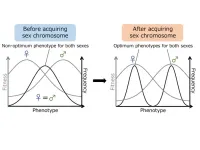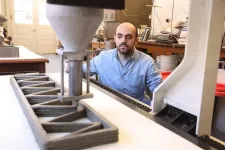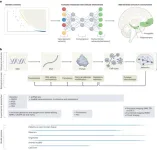(Press-News.org) Light pollution disrupts circadian rhythms and ecosystems worldwide – but for plants, dependent on light for photosynthesis, its effects could be profound. Now scientists writing in Frontiers in Plant Science have found that exposure to high levels of artificial light at night makes tree leaves grow tougher and harder for insects to eat, threatening urban food chains.
“We noticed that, compared to natural ecosystems, tree leaves in most urban ecosystems generally show little sign of insect damage. We were curious as to why,” said corresponding author Dr Shuang Zhang of the Chinese Academy of Sciences. “Here we show that in two of the most common tree species in Beijing, artificial light at night led to increased leaf toughness and decreased levels of leaf herbivory.”
Shedding some light
Artificial light has increased levels of night-time brightness by almost 10%: most of the world’s population experiences light pollution every night. Because plant properties affect their interactions with other plants and animals, any changes to plants caused by artificial light could have a significant impact on the ecosystem.
“Leaves that are free of insect damage may bring comfort to people, but not insects,” said Zhang. “Herbivory is a natural ecological process that maintains the biodiversity of insects.”
The scientists suspected that plants experiencing high levels of artificial light would focus on defense rather than growth, producing tougher leaves with more chemical defense compounds. To test this, they selected two common species of street tree: Japanese pagoda and green ash trees. Although these trees are similar in many ways, Japanese pagoda trees have smaller, softer leaves which herbivores prefer.
The scientists identified 30 sampling sites spaced by roughly 100 meters on main roads which are usually illuminated all night. To determine the level of exposure to artificial lighting, they measured illuminance at each site. Almost 5,500 leaves were collected and evaluated for insect herbivory and traits that could be affected by artificial light, like size, toughness, water content, and levels of nutrients and chemical defenses.
Larger leaves would indicate resources allocated to growth, while toughness and higher levels of chemical defenses like tannins would indicate resources allocated to defense. Meanwhile, higher levels of water and nutrients indicate higher-quality nutrition to tempt herbivores.
Hard to swallow
For both species of tree, higher levels of artificial light meant tougher leaves. The tougher the leaf, the less evidence of insect herbivory. The more intense the light, the more frequently scientists encountered leaves that showed no signs at all of herbivory.
“The underlying mechanism for this pattern is not yet fully understood,” said Zhang. “It is possible that trees exposed to artificial light at night may extend their photosynthesis duration. Additionally, these leaves might allocate a greater proportion of resources to structural compounds, such as fibers, which could lead to an increase in leaf toughness.”
Japanese pagoda trees exposed to more artificial light had lower levels of nutrients like phosphorus: where Japanese pagoda leaves had more nutrients, more herbivory occurred. But green ash leaves were more strongly influenced by higher light levels: they had higher levels of nitrogen, smaller leaves, and lower chemical defenses.
This could be because green ash trees are less preferred by herbivores, so they can afford to allocate resources to growth. Meanwhile, Japanese pagoda trees put more resources into defense, lowering their nutrient content.
Insects going hungry
“Decreased herbivory can lead to trophic cascading effects in ecology,” said Zhang. “Lower levels of herbivory imply lower abundances of herbivorous insects, which could in turn result in lower abundances of predatory insects, insect-eating birds, and so on. The decline of insects is a global pattern observed over recent decades. We should pay more attention to this trend.”
Although leaf toughness is a mechanical defense against predation, it is possible that other factors contribute to decreased herbivory: for instance, more light could make insects more visible to their predators. Further research will be needed to fully understand the effects of artificial light.
“Our study was conducted in only one city and involved just two tree species,” cautioned Zhang. “This limitation hinders our ability to generalize the conclusions to broader spatial and taxonomic scales. Research on how urbanization affects insects and insect-related ecological processes is still in its infancy.”
END
Streetlights running all night makes leaves so tough that insects can’t eat them, threatening the food chain
Scientists find that trees on streets exposed to artificial light at night have tougher leaves and are less likely to be eaten by insects, potentially damaging urban biodiversity
2024-08-05
ELSE PRESS RELEASES FROM THIS DATE:
Upfront mental health supports for men with prostate cancer
2024-08-04
Mental health screenings must be incorporated in routine prostate cancer diagnoses say University of South Australia researchers. The call follows new research that shows men need more supports both during and immediately after a diagnosis of prostate cancer.
Funded by Movember, the UniSA study tracked the scale and timing of mental health issues among 13,693 South Australian men with prostate cancer, finding that 15% of prostate cancer patients began mental health medications directly after a prostate cancer diagnosis, with 6% seeking help from mental health ...
Strengthening global regulatory capacity for equitable access to vaccines in public health emergencies
2024-08-03
WASHINGTON – Three high-impact steps could be taken by global health leaders to reshape the global regulatory framework and help address the pressing need for equitable access to diagnostics, therapeutics, and vaccines during public health emergencies, say a Georgetown global health law expert and a medical student.
In their “Perspective” published today in the New England Journal of Medicine, Georgetown School of Health professor Sam Halabi, JD, and George O’Hara, a Georgetown medical student and David E. Rogers Student ...
Sex chromosomes may reduce “sexual conflict” during evolution
2024-08-03
Tokyo, Japan – Researchers from Tokyo Metropolitan University have taken a big step in solving the mystery around why animals evolve sex chromosomes. It had long been proposed that sex chromosomes evolve to reduce “sexual conflict,” the evolution of features which are sub-optimal for either sex. By using fruit flies, the team showed that genes on newly formed neo-sex chromosomes in fruit flies tend to evolve “sex-biased genes” which give sex-specific phenotypes.
Chromosomes are neatly packaged bundles of DNA that carry all the genetic material of an organism. While prokaryotes ...
A blueprint for building the future: Eco-friendly 3D concrete printing
2024-08-02
A research team led by engineers at the University of Virginia School of Engineering and Applied Science is the first to explore how an emerging plant-based material, cellulose nanofibrils, could amplify the benefits of 3D-printed concrete technology.
“The improvements we saw on both printability and mechanical measures suggest that incorporating cellulose nanofibrils in commercial printable materials could lead to more resilient and eco-friendly construction practices sooner rather than later,” said Osman E. Ozbulut, a professor in the Department of Civil and Environmental ...
A Bronze Age technology could aid the switch to clean energy
2024-08-02
Technology with roots going back to the Bronze Age may offer a fast and inexpensive solution to help achieve the United Nations climate goal of net zero emissions by 2050, according to recent Stanford-led research in PNAS Nexus.
The technology involves assembling heat-absorbing bricks in an insulated container, where they can store heat generated by solar or wind power for later use at the temperatures required for industrial processes. The heat can then be released when needed by passing air through channels in the stacks of “firebricks,” thus allowing cement, steel, glass, and paper factories to run on renewable energy even when wind and sunshine ...
What researchers know about the genetic complexity of schizophrenia, to date
2024-08-02
Patrick Sullivan, MD, FRANZCP, the Yeargan Distinguished Professor of Psychiatry and Genetics at the UNC School of Medicine, and researchers at the Karolinska Institutet in Stockholm, Sweden, have developed a comprehensive outline of the genetics of schizophrenia. The review was published in Nature Reviews Neuroscience.
Schizophrenia is a neuropsychiatric disorder featuring recurrent episodes of psychosis – such as hallucinations, delusions, and disorganized thinking – with many patients developing apathy, social withdrawal, ...
New study highlights scale and impact of long COVID
2024-08-02
In a new review paper, researchers from the Universities of Arizona, Oxford and Leeds analyzed dozens of previous studies into long COVID to examine the number and range of people affected, the underlying mechanisms of disease, the many symptoms that patients develop, and current and future treatments.
Long COVID, also known as Post-COVID-19 condition, is generally defined as symptoms persisting for three months or more after acute COVID-19. The condition can affect and damage many organ systems, leading to severe ...
How the rising earth in Antarctica will impact future sea level rise
2024-08-02
COLUMBUS, Ohio – The rising earth beneath the Antarctic Ice Sheet will likely become a major factor in future sea level rise, a new study suggests.
Despite feeling like a stationary mass, most solid ground is undergoing a process of deformation, sinking and rising in response to many environmental factors. In Antarctica, melting glacial ice means less weight on the bedrock below, allowing it to rise. How the rising earth interacts with the overlying ice sheet to affect sea level rise is not well-studied, said Terry Wilson, co-author of the study and a senior research scientist at the Byrd Polar and Climate Research Center ...
Research spotlight: Uncovering the links between sleep struggles, substance abuse and suicidal thoughts in teens with depression
2024-08-02
Rebecca Robbins, PhD, of the Division of Sleep and Circadian Disorders at Brigham and Women’s Hospital, is the senior author of a paper published in Psychiatry Research, “Exploring sleep difficulties, alcohol, illicit drugs, and suicidal ideation among adolescents with a history of depression.”
How would you summarize your study for a lay audience?
Suicide is one of the leading causes of death for adolescents in the U.S. We know, due to previous research, that difficulty falling asleep or waking up too early as well as abuse of prescription ...
Boosting children’s voices could help to relieve significant backlogs in the family court, study says
2024-08-02
Giving children a right to be heard and taken seriously when parents separate could help couples reach sustainable child arrangements and relieve significant backlogs in the family court, avoiding unnecessary financial and emotional costs, a new study says.
Mediation, court and legal processes should provide a forum for young people’s views on post-separation arrangements being considered for them to be aired independently and factored in wherever appropriate. Giving them more agency about decisions which affect their lives and futures will help families make more effective ...
LAST 30 PRESS RELEASES:
Numbers in our sights affect how we perceive space
SIMJ announces global collaborative book project in commemoration of its 75th anniversary
Air pollution exposure and birth weight
Obstructive sleep apnea risk and mental health conditions among older adults
How talking slows eye movements behind the wheel
The Ceramic Society of Japan’s Oxoate Ceramics Research Association launches new international book project
Heart-brain connection: international study reveals the role of the vagus nerve in keeping the heart young
Researchers identify Rb1 as a predictive biomarker for a new therapeutic strategy in some breast cancers
Survey reveals ethical gaps slowing AI adoption in pediatric surgery
Stimulant ADHD medications work differently than thought
AI overestimates how smart people are, according to HSE economists
HSE researchers create genome-wide map of quadruplexes
Scientists boost cell "powerhouses" to burn more calories
Automatic label checking: The missing step in making reliable medical AI
Low daily alcohol intake linked to 50% heightened mouth cancer risk in India
American Meteorological Society announces Rick Spinrad as 2026 President-Elect
Biomass-based carbon capture spotlighted in newly released global climate webinar recording
Illuminating invisible nano pollutants: advanced bioimaging tracks the full journey of emerging nanoscale contaminants in living systems
How does age affect recovery from spinal cord injury?
Novel AI tool offers prognosis for patients with head and neck cancer
Fathers’ microplastic exposure tied to their children’s metabolic problems
Research validates laboratory model for studying high-grade serous ovarian cancer
SIR 2026 delivers transformative breakthroughs in minimally invasive medicine to improve patient care
Stem Cell Reports most downloaded papers of 2025 highlight the breadth and impact of stem cell research
Oxford-led study estimates NHS spends around 3% of its primary and secondary care budget on the health impacts of heat and cold in England
A researcher’s long quest leads to a smart composite breakthrough
Urban wild bees act as “microbial sensors” of city health.
New study finds where you live affects recovery after a hip fracture
Forecasting the impact of fully automated vehicle adoption on US road traffic injuries
Alcohol-related hospitalizations from 2016 to 2022
[Press-News.org] Streetlights running all night makes leaves so tough that insects can’t eat them, threatening the food chainScientists find that trees on streets exposed to artificial light at night have tougher leaves and are less likely to be eaten by insects, potentially damaging urban biodiversity


